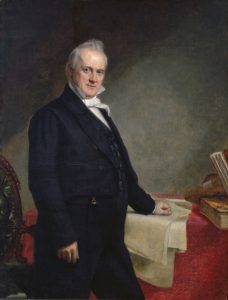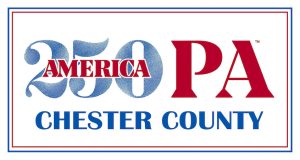Brandywine Stories: Pennsylvania’s Own, James Buchanan
An ill-fated president

Considering that the Keystone State once hosted our young nation’s capital and gave us the Declaration of Independence, not to mention a government establishing “Virtue, Liberty and Independence” for all, it’s odd that only one Pennsylvanian was ever elected to the presidency. Or at least until 2021, when Scranton-born Joe Biden assumed the office. (And compared with Virginia’s eight presidents.)
But if there was ever a person who was more qualified — yet so unsuccessful — at being President, it was James Buchanan (1791–1868) of Lancaster. As 15th president, he vowed to serve only one presidential term, from 1857 to 1861, preceding Abraham Lincoln. Buchanan also shared the quaint history that he, like Lincoln, was born in a log cabin, now located at Mercersburg Academy west of Lancaster.
But the similarities end there.
Quest for the Presidency
Considering that Buchanan is ranked near the bottom on the scale of successful presidents, it’s ironic that he was among the most politically qualified people to ever seek the office. He’d been a member of the House of Representatives and the Senate, as well as serving as Secretary of State and ambassador to both Great Britain and Russia.
Buchanan longed for the highest office, seeking the presidential nomination in 1844, 1848 and 1852 and finally succeeding in 1856, on the 17th ballot.
But as that election approached, the Pennsylvania electorate was divided about Buchanan. Yes, being a Pennsylvanian made him an instant favorite son. And, yes, he was certainly qualified. But rumors about his support of slavery made Pennsylvanians hesitant, particularly those in the emerging Republican Party, which was adamantly anti-slavery.
Townsend Walter, a successful politician of the day, wrote that concerned Republicans took it upon themselves to visit Buchanan at his home in Lancaster just before the 1856 election. The Kansas-Nebraska Act, which favored extending slavery into western territories, was making its way through Congress and eventually would be decided by the Supreme Court.
The group, made up of staunch abolitionists from Philadelphia and West Chester, called on Buchanan at his home at Wheatland. According to Walter, the question of slavery was put point blank to Buchanan, who insisted he opposed the extension of slavery into the territories. This satisfied the visitors, who returned to their homes and encouraged the vote for Buchanan.
Presidency

Buchanan won the election and was scarcely sworn in as president before he showed his true sympathies for the South. He embraced the Supreme Court’s controversial ruling in the Dred Scott case that Americans of African descent, whether free or slave, had “no right to citizenship” anywhere in the United States. He believed his support of slavery would be construed as support for the South and was mistakenly convinced such a position would prevent the looming Civil War.
Another major embarrassment for Buchanan was the so-called Utah War, which was heating up just as he was taking office. It seems that certain Mormon enclaves began shooting at anyone entering their area. Federal troops were sent to Utah to keep the peace with little success.
Buchanan, who’d once been a private in a Pennsylvania brigade, thought he could manage the uprising better than his generals. Sadly, he made so many mistakes and errors it came to be called “Buchanan’s Blunder” by many national newspapers.
Legacy
By the time Buchanan left office, seven states had seceded from the Union. Historians believe his appeasement of the South and passivity as forces tore apart the country are his sad legacy.
A minor, positive part of his legacy is that like many other presidents, he saw the United States expand with the admission of new states. For Buchanan, it was Minnesota, Oregon and Kansas — although the controversy about whether Kansas could be a slave state would also haunt his administration.
Buchanan’s birthday is April 23.
Wheatland
Perhaps Buchanan’s most visible legacy is Wheatland, his home in Lancaster. Wheatland, also called the James Buchanan House, is a Federal-style brick mansion built in 1828 and purchased by Buchanan in 1848. A lifelong bachelor, Buchanan moved into the mansion with his niece, Harriet Lane, plus a nephew and housekeeper.

When the unmarried Buchanan assumed the presidency, his niece at first became the White House hostess and soon became regarded as the First Lady. Indeed, she was the first person to be given that title by the American press.
Once Buchanan’s single term ended, he retired from all politics and spent the rest of his time at home. He died upstairs in his bedchamber at Wheatland on June 1, 1868. He was 77 years old.
In 1934, Wheatland was acquired by a nonprofit foundation to preserve the house and interpret the life of James Buchanan. It was designated a National Historic Landmark in 1961. Today, it’s managed by LancasterHistory. Visitors can view the home, inside and out, as it was in the 1860s.
Wheatland is open to the public Monday–Saturday, mid-January through mid-November, with tours available hourly. More at LancasterHistory.org.
 Malcolm Johnstone is the Community Engagement Officer for Arts, Culture and Historic Preservation for the Cultural Alliance of Chester County, an initiative of the Chester County Community Foundation. His column raises awareness of Chester County’s rich heritage as we journey to 2026: the year the U.S. celebrates the 250th anniversary of our nation’s independence.
Malcolm Johnstone is the Community Engagement Officer for Arts, Culture and Historic Preservation for the Cultural Alliance of Chester County, an initiative of the Chester County Community Foundation. His column raises awareness of Chester County’s rich heritage as we journey to 2026: the year the U.S. celebrates the 250th anniversary of our nation’s independence.
